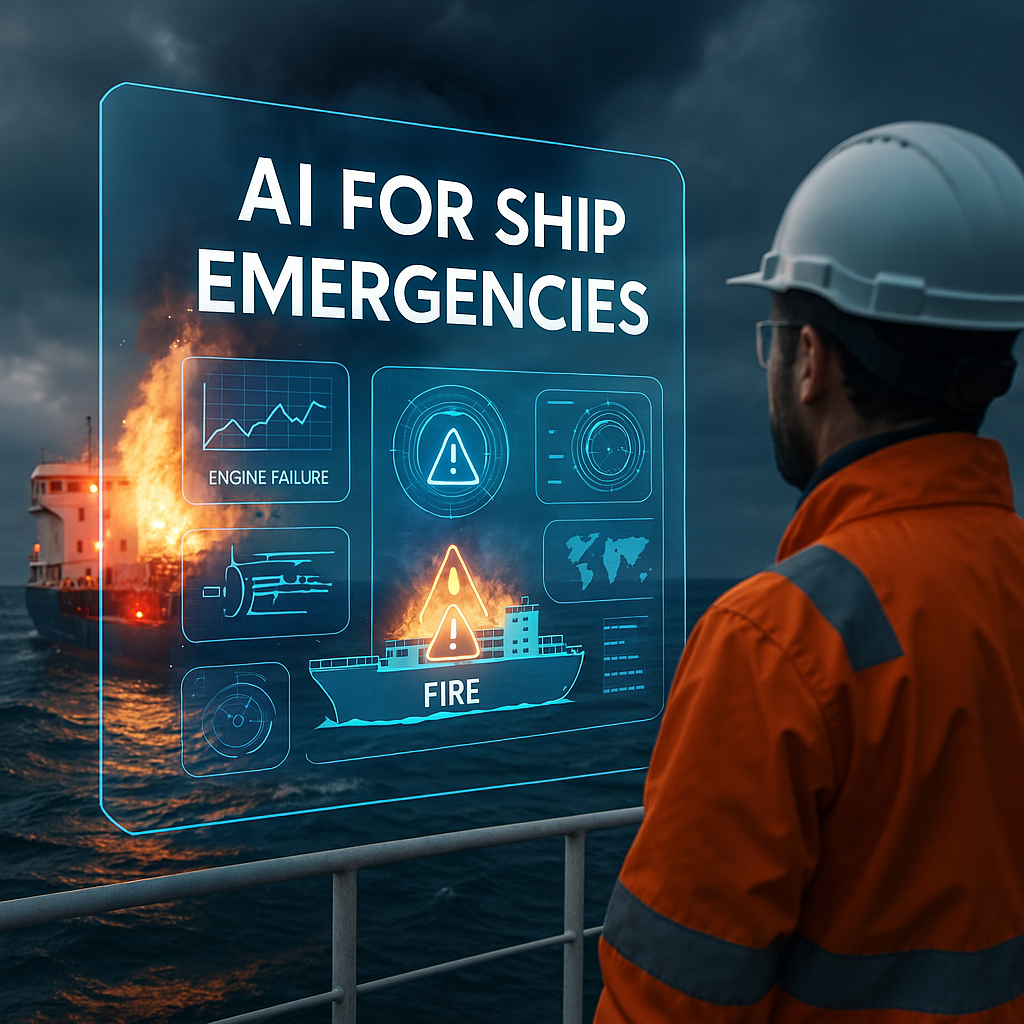Discover how AI for ship emergencies is revolutionizing maritime safety. Learn how AI predicts rogue waves, supports mayday distress calls via ChatGPT, and powers lifeboats and drone rescue systems—vital insights for maritime students and professionals.

What if a ship could detect a rogue wave before it hits? Or if a lifeboat could autonomously rescue a crew in distress?
As maritime risks increase due to climate change, traffic congestion, and extreme weather, artificial intelligence is emerging as a crucial ally in maritime safety and rescue operations. From AI predicting rogue waves to ChatGPT assisting in emergency calls and drone lifeboats performing autonomous rescues, this field is transforming how we respond to ship emergencies.
In this article, we’ll explore:
-
How deep learning predicts extreme sea conditions
-
Real-world uses of AI in mayday scenarios
-
Next-gen drone and lifeboat systems powered by AI
This guide is tailored for maritime students, cadets, officers, educators, and shipping professionals seeking to understand the future of AI in ship safety.
What Is AI in Maritime Safety?
AI in maritime safety refers to using machine learning, natural language processing, predictive analytics, and autonomous systems to prevent, detect, and respond to shipboard emergencies.
Key Benefits of AI for Ship Emergencies:
-
Predicts critical sea conditions and mechanical failures
-
Assists in real-time communication during distress events
-
Powers autonomous systems for quicker rescue response
-
Enhances decision-making for officers, search-and-rescue teams, and authorities
🚨 Keyword Spotlight: “AI for ship emergencies” is rapidly trending as ports, navies, and commercial fleets adopt smart safety technologies.
🌊 Can AI Predict Rogue Waves? New Deep Learning Models Explained
What Are Rogue Waves?
Rogue waves are unexpected, massive ocean waves, often twice the height of surrounding waves. They pose serious danger to vessels and offshore platforms.
Traditional Detection Limitations:
-
Reliant on buoy or radar data, often delayed
-
Inability to predict or model wave formation in real time
How AI Improves Detection:
-
Uses deep learning models trained on satellite, sensor, and wave pattern data
-
Learns to recognize early indicators of abnormal wave clustering
-
Forecasts rogue wave events minutes or even hours ahead
Example: MIT’s Rogue Wave Prediction Project
-
Developed a neural network that accurately predicted rogue wave formation within 30 minutes
-
Could be integrated into ship radar and bridge alert systems
📊 Impact: Early warning systems using AI could prevent dozens of maritime casualties annually, especially for smaller vessels and cruise ships.
📡 How ChatGPT Assists in Mayday Distress Calls
The Challenge:
During a distress situation, especially when language barriers, stress, or limited crew experience are involved, communication with rescue authorities can be unclear or delayed.
The Solution:
AI-powered language models like ChatGPT and voice assistants help with:
-
Translating distress messages in multiple languages
-
Drafting structured mayday messages per IMO and SOLAS standards
-
Providing step-by-step guidance (e.g., “How to use EPIRB” or “What to say on Channel 16 VHF”)
Use Case Scenario:
A multilingual crew sends a mayday message using a satellite-based chatbot interface powered by ChatGPT. The AI:
-
Translates the message into English
-
Formats it using standard distress protocol
-
Sends GPS coordinates and emergency type to MRCC (Maritime Rescue Coordination Center)
🧠 Tip for Training: Maritime schools can now simulate distress calls using ChatGPT, helping cadets practice real-world safety communication scenarios.
🚁 AI-Powered Lifeboats and Drone Rescue Systems
Autonomous Lifeboats:
AI-based lifeboats can:
-
Navigate automatically to designated safe zones
-
Use thermal imaging and sonar to find survivors in rough seas
-
Communicate with nearby ships and MRCCs via AI-enhanced radio links
Drone Rescue Systems:
Unmanned aerial vehicles (UAVs) powered by AI are now used to:
-
Search large areas quickly with image recognition software
-
Drop life jackets, beacons, or buoys to stranded individuals
-
Deliver first aid kits and communication tools before manned rescue arrives
Case Study: DLR’s “SAR Drones” (Germany)
-
Drones equipped with AI computer vision helped reduce rescue location times by 40% in simulations
-
Trained to detect life rafts, humans in water, or debris fields from aerial data
⚓ Innovation Alert: Autonomous rescue systems are being explored by NATO navies, search-and-rescue agencies, and advanced cruise lines.
🔍 Latest Trends in AI-Powered Maritime Emergency Response
| Innovation | Application |
|---|---|
| Predictive Storm & Swell Models | AI uses global weather/ocean data to alert ships of cyclone risks |
| Onboard AI Decision Support | Offers recommendations to bridge officers during engine or fire alarms |
| Rescue Simulation with AI Trainers | Cadets train in AI-driven digital environments replicating real scenarios |
| Satellite-AI Collision Warnings | Predicts ship collisions or grounding based on AIS + satellite input |
📈 Forecast: According to Lloyd’s Register, AI-enhanced emergency systems will be standard on 70% of commercial ships by 2030.
FAQs: People Also Ask
Can AI predict ocean disasters?
Yes. AI can predict rogue waves, cyclones, and high-impact swell patterns by analyzing historical and live data.
How do AI lifeboats work?
AI lifeboats use GPS, sonar, and pre-set navigation algorithms to reach safe zones and detect people in the water autonomously.
Can AI help during mayday calls?
Yes. AI can translate, structure, and transmit distress messages while also guiding the crew with emergency procedures.
Are drones reliable for ship rescues?
Drones can cover large areas faster than helicopters, identify targets with computer vision, and assist until help arrives.
Conclusion
From forecasting rogue waves to autonomous rescue operations, AI for ship emergencies is reshaping maritime safety. These technologies enhance human response, reduce loss of life, and increase the efficiency of rescue operations.
🚢 Call to Action: For cadets, ship officers, and maritime companies—embrace AI as a safety asset. Train with it. Test it. Trust it. The future of maritime rescue is not just human—it’s human + AI.
References & Further Reading
Suggested Internal Links (for MaritimeEducation.com )
AI vs. Pirate Hackers: How Artificial Intelligence Is Securing Maritime Cybersecurity
STCW-Compliant VR Maritime Training: The Future of Seafarer Education and Certification

